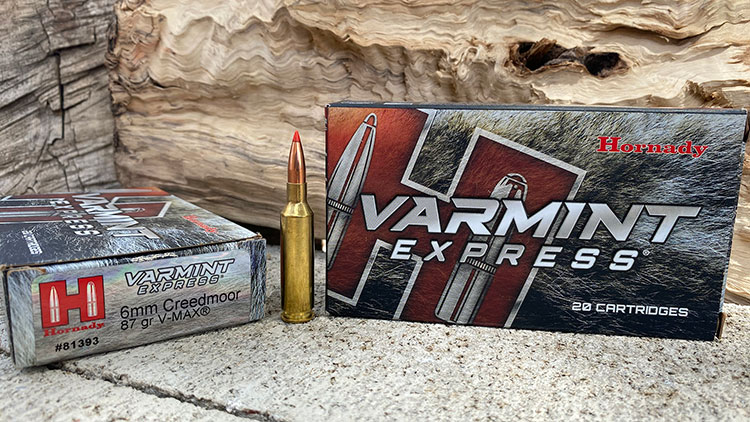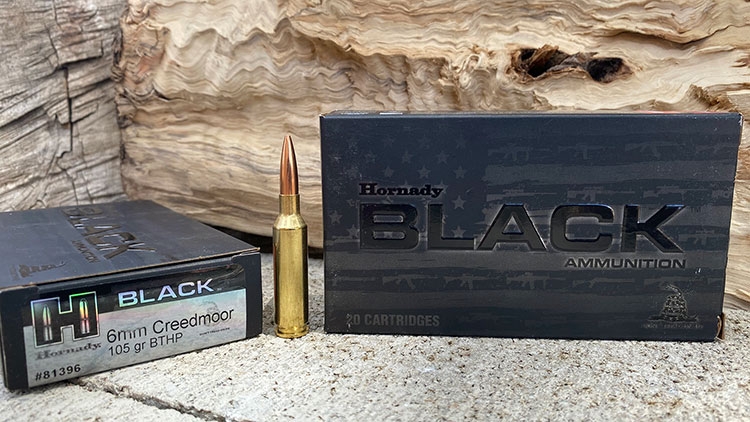How Accurate Is Factory Ammo when Paired with a Custom 6mm Creedmoor Rifle Part II: The Range Report
We’re entering the second phase of the project to measure the accuracy of factory ammo in a custom 6mm Creedmoor rifle. I needed to decide exactly what factory ammunition to test. Should I only test ammo that is more suited for the 1-in-8 twist? Or, should I choose only match or hunting ammunition? I decided that for the most comprehensive results, I would test them all. To clarify, I didn’t test every 6mm Creedmoor ammunition made; however, I did test all ammunition I could get my hands on. I received the ammo from multiple sources, including local gun stores, online orders, and some that was generously supplied by Peterson Cartridge Company.
Hornady Precision Hunter – 103 grain Hornady ELD-X
Hornady Varmint Express – 87 grain Hornady V-Max
Peterson Precision Ammunition – 108 grain Hornady ELD-M
Barnes VOR-TX LR – 95 grain Barnes LRX
Hornady Black – 105 grain Hornady BTHP
Hornady Match – 108 grain Hornady ELD-M
Federal Premium Gold Medal – 105 grain Berger Hybrid OTM
Federal Premium Gold Medal – 107grain Sierra Matchking
With ammo in hand, I packed up the equipment, ammunition, rifle, and headed to the range. The first order of business was to break in the Rock Creek Barrel. I know there are many opinions on the subject of breaking in a barrel, and those who prefer to do so have their own methods. My thoughts are this: I need to sight in the rifle anyway, and a few extra shots down the barrel with cleanings in between will not hurt anything.
My process is this: shoot one round and clean (repeat five times); then, shoot three shots and clean (repeat five times). The barrel break-in is now complete using a single box of ammo. I prefer to use Montana X-Treme cleaning rods, solvents, patches, brushes, and jags.
For the barrel break-in, I used the Bore Solvent. It is a general-purpose cleaning solvent that works well on carbon and copper fouling. It is also safe on your barrels, unlike other more aggressive solvents.
Now on to the accuracy testing. For stability, I shot the ammunition from a bench using the Accuracy Solutions Bipod XT with the Accu-Tac HD50 bipod and a rear bag. This provided a rock-solid setup with no inadvertent movement of the rifle.
I utilized a Labradar to obtain the muzzle velocities and statistics of the ammo performance. I also used the Longshot LR-3 – 2 Mile UHD to record target impacts. I had zero issues with the cameras and ran them all day with no interruptions in communication or battery life. I’ll be releasing a full review of this system in the future so stay tuned! Finally, I used the Sub-MOA Application to calculate the final groups (which were verified by hand).
Ammunition Test Results
Hornady Precision Hunter – 103 grain Hornady ELD-X
With the barrel break-in behind me, I jumped into shooting the five-shot groups. For each ammo, I shot two five-shot groups and documented the results of each group size, average group size, average velocity, extreme spread, and standard deviation. The first ammunition I tested was the Hornady Precision Hunter, which is loaded with the Hornady 103 grain ELD-X.
The ELD-X stands for Extremely Low Drag – Expanding making them a perfect choice for hunting applications. They feature match-grade accuracy paired with controlled expansion. These bullets lived up to their name and shot well with a group size of 0.96 inches and 0.70 inches for an average group size of 0.83 inches.
Peterson Precision Ammunition – 108 grain Hornady ELD-M
The second ammo I tested was the Peterson Precision Ammunition loaded with Hornady 108 gr ELD-M. The ELD-M stands for Extremely Low Drag – Match which features Heat Shield Tips. This ammunition shot extremely well with a group size of 0.65 inches and 0.62 inches for an average group size of 0.635 inches.
As of July 1, 2020, this ammunition is not available for purchase but will be released in the near future. Graf and Sons is the exclusive distributor for Peterson Cartridge so check out www.grafs.com for this ammo to drop. Peterson also makes a 105gr using Berger Hybrid Target bullets and loads up 90gr Sierra GameChangers bullets. Unfortunately, neither of these were available to include in our testing.
Hornady Varmint Express – 87 grain Hornady V-Max
Next on the list was the Hornady Varmint Express loaded with 87gr V-MAX bullets. They are a swaged lead core bullet, with a hollow cavity for extreme rapid expansion. The V-MAX bullets feature explosive terminal performance and are definitely a favorite among varmint hunters.
Although I absolutely love V-MAX bullets, they did not perform as well as others in this test. One issue is the bullet weight; the 87-grain bullet is a bit light for the 1-in-8-inch twist of this rifle, and the results verify this fact. This ammunition shot group sizes of 1.55 inches and 0.99 inches for an average group size of 1.27 inches.
Barnes VOR-TX LR – 95 grain Barnes LRX
The fourth ammunition I tested was the Barnes VOR-TX LR – Long Range Ammunition. I have to admit, I have not shot a ton of Barnes ammunition over the years, but I was impressed with its performance. The VOR-TX LR bullets feature a polymer tip for increased ballistic coefficient, an engineered scored nose cavity which produces razor sharp petals upon expansion, and Accu-Groove technology for minimal fouling. All this combines to create superior accuracy.
This hunting ammo was in the top three for average group size and was only beat out by match ammo. The Barnes shot a group size of 0.78 inches on the first and 0.55 inches on the second for an average group size of 0.665 inches. I also used this ammunition in my hunt review of the 6mm Creedmoor build and am happy to report it performed exceptionally.
Hornady Black – 105 grain Hornady BTHP
Just over halfway in the list is the Hornady Black 105gr BTHP [Boat Tail Hollow Point]. Although this ammunition is optimized for gas guns, it doesn’t mean it won’t shoot lights out from bolt action rifles. This ammunition is loaded with the .243 diameter 105gr BTHP from Hornady. These match bullets claim to be the most consistently concentric bullet jackets available with near-zero wall thickness variation.
These bullets produced groups in the middle of the pack with acceptable accuracy. This ammunition shot a group size of 0.93 inch and 0.70 inch for an average group size of 0.815 inch.
Hornady Match – 108 grain Hornady ELD-M
Number six, the one, the only, Hornady Match – 108gr ELD-M. Now we have already covered this Hornady bullet above, as it is loaded in the Peterson Cartridge Ammunition, and there must be a reason this bullet shows up twice in our list. That reason is accuracy. You are now reading about the most accurate ammunition we tested. In addition to all the features discussed the 108gr ELD-M bullets, Hornady takes the precision one step further with their match ammunition. The match ammunition boasts rigorous quality control, carefully selected cases, and when paired with match-grade bullets, make for a great combination.
As stated above, this was the most accurate ammunition tested and shot the smallest group of the day with a group size of 0.48 inches and 0.69 inches for an average group size of 0.585 inches. Who says you can’t shoot a half-inch group with factory ammo?
Federal Premium Gold Medal – 105 grain Berger Hybrid OTM
At number seven we have the Federal Premium Gold Medal loaded with 105gr Berger Hybrid OTM. Berger bullets are considered by many to be the best bullets available and the 105 Hybrid OTM [ Open Tip Match] is no exception. Berger Hybrid bullets are made with their hybrid ogive which blends tangent and secant designs to optimize efficiency, reduce wind-drift, and minimize sensitivity to seating depth.
Although these bullets are exceptional, this ammunition did not shoot as well as others that we tested. This ammunition shot a group size of 0.86 inches and 0.83 inches for an average group size of 0.845 inches.
Federal Premium Gold Medal – 107grain Sierra Matchking
Last but certainly not least we have the Federal Premium Gold Medal loaded with 107gr Sierra Matchking. The Sierra Matchkings are known for record-setting accuracy and they proved to shoot extremely well from our custom rifle. Sierra states that although they are not recommended for most hunting applications, they are commonly used for varmint hunting, albeit without the same reliable explosive expansion at equivalent velocities in varmints compared to their lightly jacketed bullets, such as the Blitzking.
This ammo had the second-smallest group of the day with a group size of 0.53 inches, but then a group of 0.87 inches for the second. This equated to an average group size of 0.70 inches.
Summary
From the results of our range test, you can see that there was definitely some ammunition that shot better than others. That being said, every rifle will shoot differently and shoot some ammo better than others. This fact is very important because it is not the intention to diminish reliability in one brand over another. So, lets briefly go back and review the questions we set out to answer in this project.
How accurate is the factory ammo shot from a custom rifle?
The answer is very accurate. We had seven of the eight ammunition options consistently shoot under 1-inch groups, with a couple shooting near or under 0.5-inch groups. This is more than many people achieve with hand loads from factory rifles.
For hunting situations, does quality factory ammo shoot well enough in a long-range custom rifle?
In the group of eight ammunition choices, I would classify two as hunting ammo: the Hornady Precision 103gr ELD-X and the Barnes VOR-TX LR. Both of these ammunitions are more than adequate for hunting purposes.
Conclusion and Final Thoughts
This rifle was truly a work of art, with every component chosen for optimum performance. It shot extremely well over a wide variety of ammunition choices and generally preferred the heavier bullets, which makes sense with the faster twist rate. The anomaly to this was the Barnes VOR-TX LR – 95gr LRX. As a hunting bullet, they rivaled other match bullets and were outstanding. Based on these results, we will be using the Barnes ammunition in our upcoming hunt test.
Guns/Reloading/Technical Writer at Varminter Magazine
David has been reloading and hunting varmints for over 40 years. As an engineer he enjoys the precision and technical challenges associated with handloading and long range shooting. When there are no varmints running about he enjoys a variety of long range competitions.




















